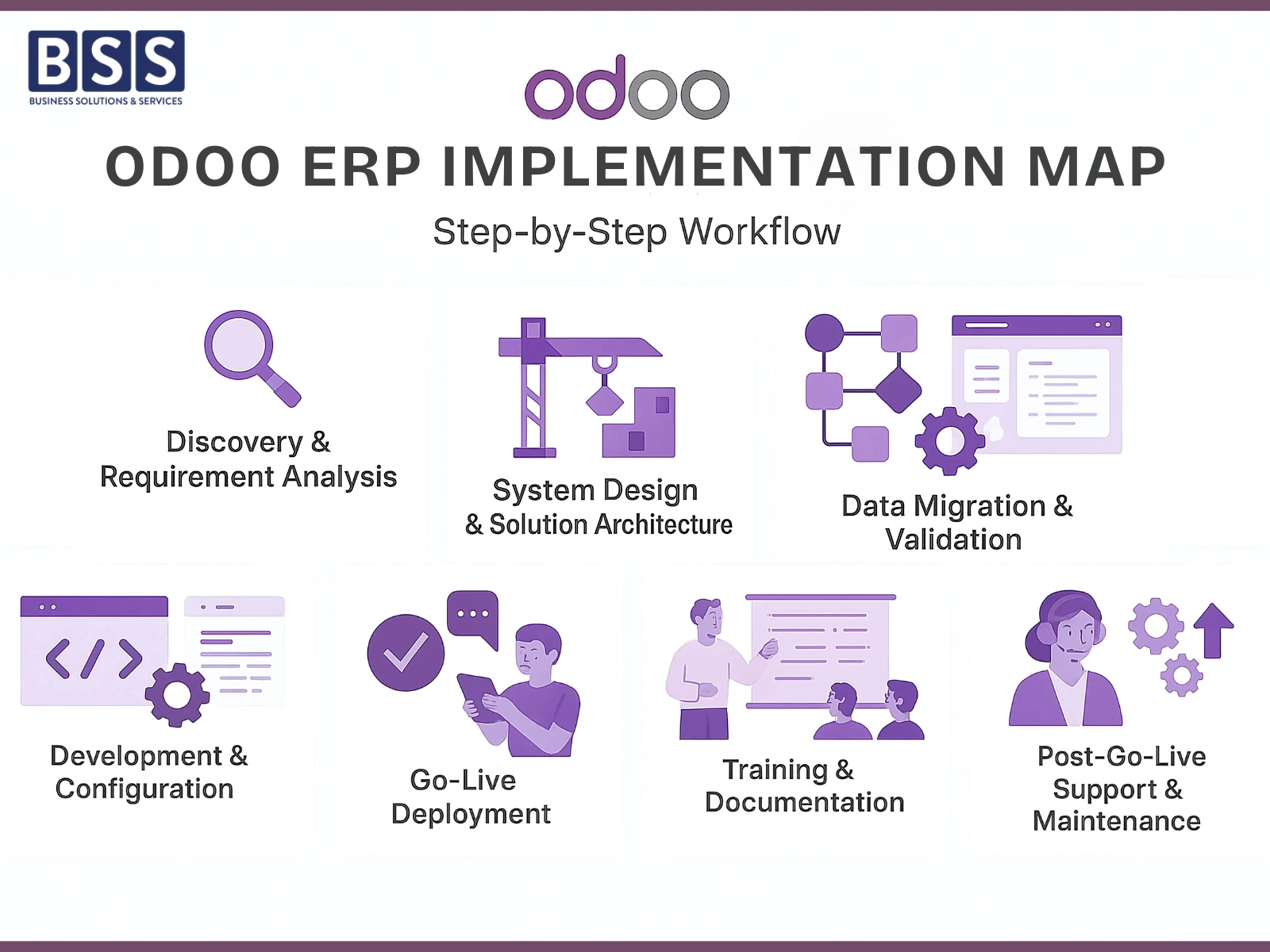What is Odoo ERP Implementation?
Odoo ERP implementation refers to the structured process of setting up Odoo’s modular ERP platform to streamline business processes. It includes discovery, customization, data migration, user training, and post-launch support.
Snippet Summary: Odoo ERP implementation involves planning, customization, and deployment of the Odoo platform tailored to your business.
Why is Odoo ERP Implementation Important?
- Aligns business operations under one unified platform
- Eliminates manual processes and improves productivity
- Reduces data errors and boosts decision-making accuracy
Benefits:
- Modular design (choose what you need)
- Cloud or on-premise flexibility
- Seamless integration with third-party tools
Odoo ERP Implementation Workflow (8 Key Stages)
1. Discovery & Requirement Analysis
Goal: Understand your business goals, pain points, and workflows.
Key Activities:
- Stakeholder interviews
- Current process audits (sales, HR, finance)
- Identify gaps and inefficiencies
- Module mapping and SRS documentation
Real Query Covered: “How do I know which Odoo modules my business needs?”
2. System Design & Solution Architecture
Goal: Architect a scalable and modular ERP system.
Key Activities:
- Process mapping and workflows in Odoo
- Choose between cloud/on-premise
- Plan for scalability and integrations (Shopify, PayPal, CRMs)
Example: A retail business integrates Odoo Inventory with Shopify and payment gateways for automated order fulfillment.
3. Development & Configuration
Goal: Customize Odoo modules to align with business operations.
Key Activities:
- Install modules and environments
- Configure settings (tax rules, user roles, workflows)
- Custom features via Python/Odoo Studio
- Internal testing to ensure performance
Query Covered: “Can I customize Odoo to fit my unique business requirements?”
4. Data Migration & Validation
Goal: Migrate accurate historical data from legacy systems.
Key Activities:
- Field mapping between systems
- Data cleaning and formatting templates
- Batch import of master data and transactional history
- Validation checks for integrity
Query Covered: “Will I lose my existing data when switching to Odoo?”
5. User Acceptance Testing (UAT)
Goal: Verify system performance in real-world scenarios.
Key Activities:
- Simulate daily workflows with end users
- Log bugs or UX issues
- Final approval before launch
Query Covered: “How is system quality tested before going live?”
6. Training & Documentation
Goal: Ensure all users are comfortable using the system.
Key Activities:
- Role-specific training for departments
- Admin training for system management
- Provide user manuals and SOPs
Query Covered: “Will my team get training on how to use Odoo?”
7. Go-Live Deployment
Goal: Move the tested system into the live environment.
Key Activities:
- Final data upload
- Set up backups and domain/SSL
- Activate system and monitor activity
Query Covered: “What happens on the Go-Live day?”
8. Post-Go-Live Support & Maintenance
Goal: Ensure long-term system success and scalability.
Key Activities:
- Bug fixes and minor enhancements
- Monitor performance metrics
- Plan upgrades and add-ons
Query Covered: “What kind of support is available after going live?
Real Use Case: Odoo ERP for SMEs in the UAE & USA
Example: A UAE-based logistics company implemented Odoo to unify CRM, invoicing, and warehouse modules. Within 3 months, invoice generation time dropped by 40%, and customer satisfaction improved through real-time tracking.
Market Relevance: Odoo is highly adopted in industries like logistics, healthcare, retail, and manufacturing across the UAE, KSA, and USA.
How Long Does Odoo ERP Implementation Take?
- Small business (1–3 modules): 4–6 weeks
- Medium-scale deployment: 2–3 months
- Large enterprise (full suite): 4–6 months
Query Covered: “How long does it take to fully implement Odoo ERP?”
Need custom features or new modules to fit your unique business needs? Our Odoo development team creates scalable solutions that enhance functionality, automate tasks, and improve system efficiency. From bespoke apps to complex workflows, we turn your requirements into reality. Unlock the full potential of Odoo for your business—hire our developers today.
FAQs About Odoo ERP Implementation
H3: How do I know which Odoo modules my business needs?
We begin with a complete business process audit to map your workflows and identify the most relevant Odoo modules. Depending on your needs, this may include CRM, Sales, Inventory, Accounting, HR, or other specialized modules, ensuring you invest only in features that improve efficiency.
H3: Will I lose my existing data when switching to Odoo?
No. We handle data migration with secure field mapping, validation checks, and backups to ensure all your records transfer smoothly. Our process minimizes downtime and eliminates the risk of data loss or corruption during the transition.
H3: Can I customize Odoo to fit my unique business requirements?
Yes. Odoo offers full customization through Python scripts, Odoo Studio, or tailor-made modules. This flexibility ensures the system aligns perfectly with your specific workflows, industry standards, and operational goals.
H3: How is system quality tested before going live?
We conduct thorough User Acceptance Testing (UAT) where your team simulates real operations in a test environment. This process helps us identify and resolve issues before the system is deployed, ensuring a smooth go-live experience.
H3: Will my team get training on how to use Odoo?
Yes. We provide role-based training sessions, administrator tutorials, and detailed SOP documentation. Our goal is to empower your team with the skills and confidence to fully utilize Odoo from day one.
H3: What happens on the Go-Live day?
On go-live day, we switch your system from testing to production, upload final data, enable monitoring tools, and have our technical team ready for immediate support to handle any urgent adjustments.
H3: What kind of support is available after going live?
We offer SLA-based post-implementation support, including bug fixes, system performance monitoring, and upgrade planning. This ensures your Odoo platform continues to run smoothly and adapt to evolving needs.
H3: Is Odoo suitable for small and medium-sized businesses (SMBs)?
Yes. Odoo’s modular and scalable design makes it ideal for SMBs. You can start with essential modules and add more as your business grows, keeping costs manageable while ensuring flexibility.
H3: Can Odoo integrate with Shopify or PayPal?
Yes. Odoo supports seamless integrations via APIs with Shopify, PayPal, Amazon, and other platforms, allowing you to connect sales, payments, and inventory in one central system.
H3: How long does Odoo implementation take?
Implementation timelines depend on project scope. Simple setups with basic modules can take 4–6 weeks, while large-scale ERP projects involving multiple departments may take 4–6 months.
Ready to Implement Odoo ERP?
Work with Business Solutions and Services (BSS) — a certified Odoo partner trusted by enterprises across UAE and USA.
- Custom development
- Seamless migration
- End-user training
- Post-launch support
Book your FREE Odoo Consultation today and start your ERP journey with confidence.

